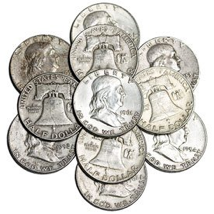
Among all the choices you have for gold and silver bullion, genuinely historic metal is still around at reasonable prices. The runaway classic is ninety-percent U.S. silver coinage.
The lyrical ring of a handful of silver coins speaks not only to the history of the United States but also the entire heritage of sound money. Simply put, pre-1965 silver used to be called “pocket change.” Everyone had some, saved some, spent some. Silver money was a natural part of everyday life.
Today, those circulated silver coins are the remnants of economic confidence Americans once took for granted. After the government cut the cord to gold in 1933, Americans still had their silver for another three decades.
Congress abandoned silver coin currency in 1965 as the nation was slipping into irreparable bankruptcy.
President Lyndon Johnson demonstrated his economic ignorance by warning Americans against hoarding the silver coins. “There will be no profit in holding them out of circulation for the value of their silver content.”

Today, ninety-percent means dimes, quarters, and half-dollars minted for circulation before 1965. That does not include silver John F. Kennedy halves minted 1965-70 carrying forty-percent silver. Circulating silver coins survived a few extra years to honor the slain president.
Nor does it include U.S. silver nickels (1942-45). For over three years, five-cent coins were 35% silver. Nickel for plating armor on WWII’s tanks and ships was too valuable to use in coins.
We’re also not talking about U.S. silver dollars (also ninety-percent), but cast with 6.5% more silver than you’ll find in ten dimes, four quarters, or two halves. Hefty silver dollars are in a class by themselves.
Another name for ninety-percent silver is “junk silver.” That name came from coin dealers selling collectible rarities, decades before bullion was popular. To those dealers, ninety-percent silver was junk – valuable but unloved. Not so today, but the unflattering name stuck.
















